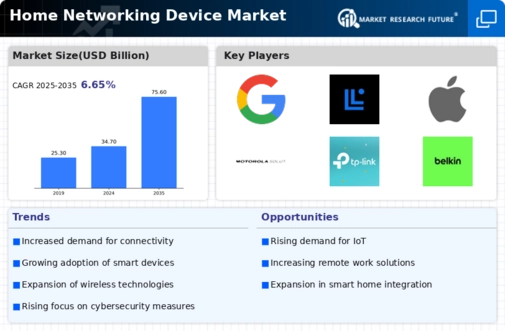Emergence of 5G Technology
The emergence of 5G technology is poised to transform the Global Home Networking Device Market Industry. With its promise of ultra-fast internet speeds and low latency, 5G is expected to facilitate the development of new home networking solutions that can leverage these capabilities. As consumers increasingly adopt 5G-enabled devices, the demand for compatible home networking equipment will likely rise. This technological advancement may lead to innovative products that enhance user experiences, such as improved streaming and gaming capabilities. The integration of 5G into home networking solutions could potentially reshape the market landscape, driving growth and innovation in the coming years.
Rise of Smart Home Technology
The integration of smart home technology significantly influences the Global Home Networking Device Market Industry. With the increasing adoption of IoT devices, such as smart thermostats, security cameras, and voice assistants, the need for efficient home networking solutions escalates. These devices require seamless connectivity to function optimally, thereby driving the demand for advanced routers and extenders. As consumers invest in smart home ecosystems, the market is expected to expand, potentially reaching 75.6 USD Billion by 2035. This trend indicates a shift towards more interconnected living environments, necessitating sophisticated networking infrastructure to support the growing number of connected devices.
Expansion of Remote Work Culture
The ongoing expansion of remote work culture significantly impacts the Global Home Networking Device Market Industry. As more companies adopt flexible work arrangements, employees require reliable home networking solutions to maintain productivity. This shift has led to an increased demand for high-performance routers and mesh networks that can support multiple devices simultaneously. The market's growth trajectory indicates a potential compound annual growth rate of 7.33% from 2025 to 2035, reflecting the sustained need for enhanced connectivity solutions in home environments. This trend underscores the importance of robust networking infrastructure as remote work becomes a permanent fixture in many industries.
Growing Awareness of Cybersecurity
In the context of the Global Home Networking Device Market Industry, the rising awareness of cybersecurity plays a crucial role in shaping consumer preferences. As more individuals connect their devices to the internet, concerns regarding data privacy and security have intensified. This awareness drives consumers to seek home networking devices equipped with advanced security features, such as firewalls and encryption protocols. Manufacturers are responding by developing products that prioritize security, thereby enhancing their appeal in the market. This trend suggests that as cybersecurity becomes a focal point for consumers, the demand for secure home networking solutions will likely increase, influencing overall market growth.
Increasing Demand for High-Speed Internet
The Global Home Networking Device Market Industry experiences a surge in demand for high-speed internet connectivity. As households increasingly rely on multiple devices for streaming, gaming, and remote work, the need for robust networking solutions becomes paramount. In 2024, the market is projected to reach 34.7 USD Billion, driven by the proliferation of smart home devices and the growing trend of digitalization. This demand is likely to continue, as consumers seek reliable and fast internet connections, which in turn propels the adoption of advanced home networking devices. The industry's growth reflects a broader shift towards enhanced connectivity in everyday life.



















Leave a Comment